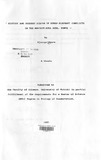| dc.description.abstract | The management of large mammals such as elephant,
rhino, lion, and tiger often entails dealing with people
related problems at the interface between protected areas
and areas with other land uses. This thesis describes,
examines, and evaluates the history, nature, and extent of
human-elephant conflicts at the interface between Tsavo West
National Park and adjacent human settlements. The
implications of these relationships to traditional
agriculture and rural social economics are then reviewed.
The resultant attitudes and perceptions regarding
conventional government approach to wildlife conservation
and management, and the factors controlling them are then
described. Limited comparisons of the attitudes and
perceptions with those an adjacent area with no history of
human-elephant conflicts are made.
Data on history, nature and ext~nt ot"conflicts were
collected using a questionnaire. Th~ same questionnaire
provided a conceptual and methodological framework for
investigating attitudes, perceptions, and awareness in both
areas. Data on the current levels of crop damage by
elephants were collected by, on the spot assessment of
elephant crop damage throughout the growing season of food
crops.
Crop damage by many wild animals was widespread and the
most significant negative effect that wild animals had on
people in the lower zones of the Taita area of kenya.
Elephants were the most significant, however, and also
caused several other direct and indirect negative effects.
Although they may not have always been the worst mammalian
pests, elephants' perception by people as overwhelming
beings to deal with, may have lead to their being perceived
as the worst.
Although conflicts between people and elephants had
always occurred in the past, two previous events had greatly
worsened the situation. First, the increased encroachment
by subsistence cultivators on to land previously seen only
as useful to livestock and wild life, and secondly the
widespread poaching of elephants in national parks that made
areas close to people relatively safer for the elephants.
Attitudes toward wild animals in general, and this
includes elephants were, contrary to popular assertions
fairy favorable. These attitudes were, however, of a
utilitarian nature and residents resented or had negative
attitudes toward aspects of wildlife conservation they felt
did not benefit them or those that made them incur losses.
Perceptions concerning who benefits from contemporary
wildlife conservation in the area were consistent with
expectations under conventional centralized wild life
conservation where ordinary people tend to distance
themselves from any benefit accrued by governments.
Although awareness on wildlife conservation was low among
residents, attitudes were not free of its influence. This
was not true of perceptions.
Human food crops might just have been be the preferred
food for elephants rather than a vital resource for use in
bad times.
These findings contribute to the understanding needed
in conflict resolution at a time when the tide in wildlife
management is in favor of unconventional and innovative ways
of redressing conflicts between people and wild animals | en |

